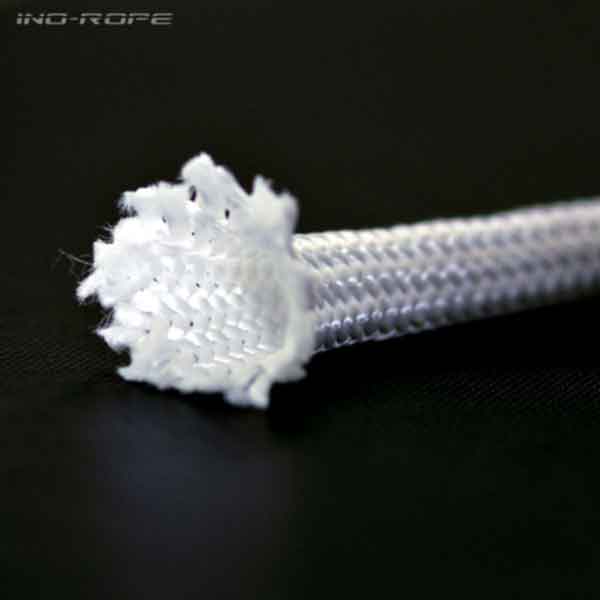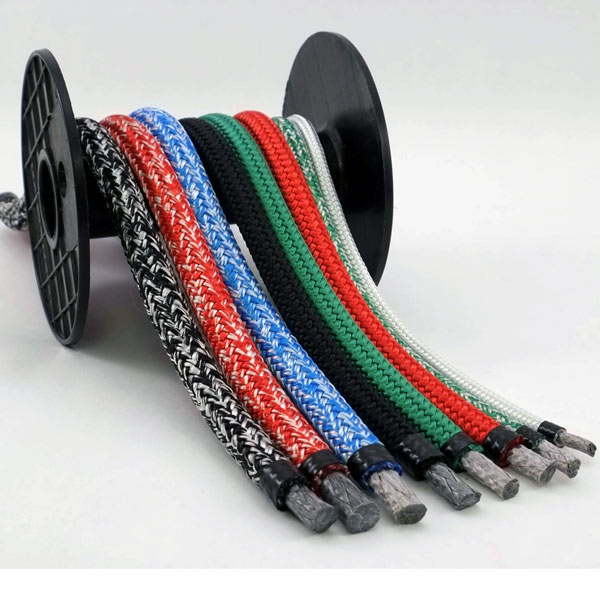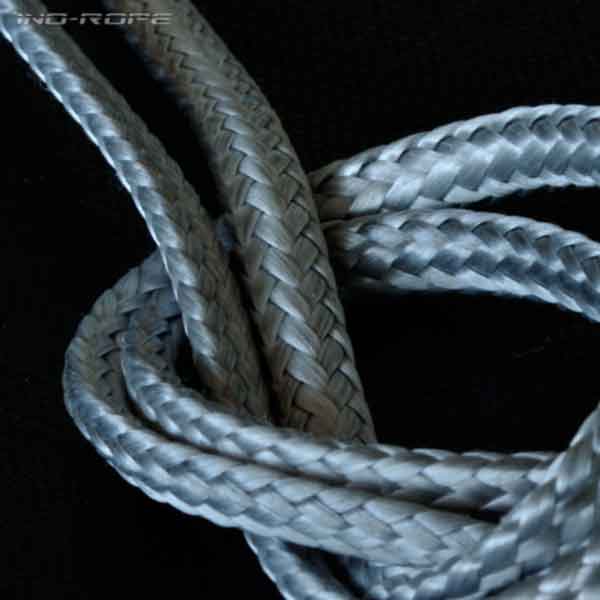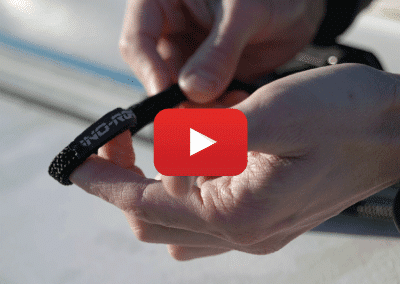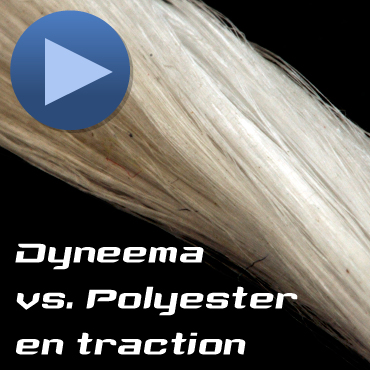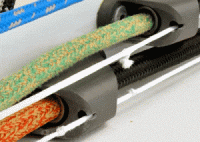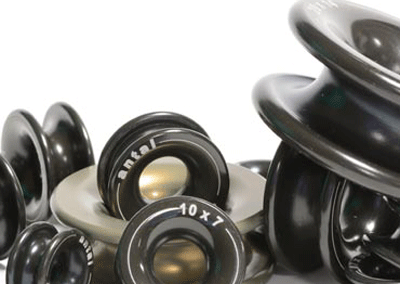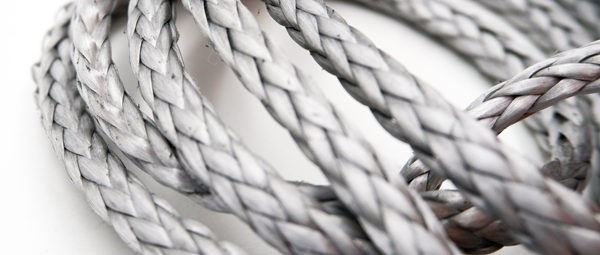
Dyneema in every state!
Shop-talk about Dyneema! Everyone gives a personal opinion but without enough technical background to keep afloat. Halyard, back stay, inner forestay, textile attachments, chafe sleeve, spare shrouds, lifeline rails: there is a specific type of braid for each use. Follow the guide !
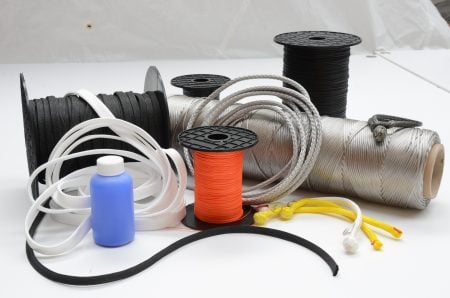
Like “Kleenex, Scotch or Fridges”, Dyneema is a commercial brand name, a pretty little name, much sexier than “high modulus polyethylene”, the fibre derived from oil that it refers to. You can also use the English acronym HMPE (High Modulus Polyethylene), with the right accent. Dyneema has been commercialised since 1990 by the Dutch company DSM, which controls the fabrication process under licence. In the United States, high modulus polyethylene is better known as Spectra, a competitor’s fibre launched in 1983 by Allied Signal, which then became Honeywell. Dyneema is available with different fibre moduli. The higher the modulus is, the better the fibre quality is (see text box: ” Dyneema moduli”). But the quality of the fibre is not all. The processes used by rope-makers during the fabrication of the rope (braiding, coating, pre-stretching, etc.) also affect the properties of the finished product. Basically, there is a whole range of Dyneema braids: enough to get one’s plaits in a twist when you’re no pro! To buy a rope suitable for its use, you need to know the constraints of the application: stiffness, abrasion resistance, ease of splicing, lifespan, reasonable budget…Tell us what you need !
I would like Dyneema halyards
The stiffness of the halyards directly affects the boat’s performance. A halyard that acts like elastic gives the luff tension a yo-yo effect! A sail that is incorrectly set in the wind puffs is a real waste of energy because some of the wind is not turned into speed. That is why, Dyneema, with minimal elongation compared to polyester, is the ideal fibre for halyards. But, be careful! There is often confusion between the properties of the fibre and that of the braided rope. It is an erroneous common belief that a Dyneema fibre, which has 3% elongation, makes a rope that also has 3% elongation. It would be true if the fibres were parallel to each other, which is not the case. A braid is naturally more elastic because the fibres that are assembled in plaits are not oriented along the axis of the rope. The tighter the braiding pitch is, the wider the angle of the plaits is, in relation to the axis of the rope, so the plait is more elastic. On the other hand, the longer the braiding pitch is, the more aligned the plaits are in the working load axis of the rope, so the stiffer it is. Conclusion: buying a Dyneema rope with a short braiding pitch for a halyard is absurd !
I would like to make textile attachments
Lashing, loops, textiles shackles… These modern attachments are so handy! Much lighter than stainless steel fittings, they are also considerate enough not to cause damage around them; when the sails flap, they shake and wave energetically. Characterised by a very low friction coefficient, Dyneema is an extremely slippery fibre and, thus highly abrasion resistant. Like people who are indifferent to criticism, a fibre with low hooking power is less sensitive to external aggression. Though once again, only taking into account the properties of the fibre for judging the rope’s characteristics is a mistake. A short braiding pitch enables, for example, to increase the resistance to abrasion because the plaits protect each other. Finally, coating increases abrasion resistance: The plastic film that coats the fibres protects them efficiently from aggression (salt crystal, sand, chafing). Coating also prevents Dyneema from forming “bobbles”: an external sign of wear, which decreases the braid’s resistance (the internal fibres remain intact) but increases the braid’s abrasion sensitivity. The bobbles hook onto everything and accelerate the rope’s wear.
I would like Dyneema but I can’t afford it.
Just as one is not drier with a gold hemmed raincoat, Dyneema is not a sensible investment for fair weather leisure cruising. Ropemakers are beginning to offer more affordable products for the average consumer. This is the case for Marlow who launched a “D2 Club” halyard. It is a Dyneema SK38 modulus, less robust than Dyneema SK75 (see text box: “Dyneema moduli”). The resistance of the SK38 model is, indeed, equivalent to that of polyester, which is largely sufficient for cruising, but its elongation is much lower. That final point is significant with regard to halyards. On the other hand, Lancelin designed the Punch halyard, a nice cocktail that combines Dyneema and polypropylene. Polypropylene ropes are commonly used for towing as they are elastic and float: like Dymeema, polypropylene is hydrophobic and very light. However, its elasticity, superior to that of polyester, prevents it from being used to make halyards. Dyneema’s low elongation compensates for the elasticity of polypropylene, while remaining within an affordable price range. These new ropes have sections comparable to those of polyester ropes. So, the weight-saving in the upper-parts is not substantial. But does that really matter for cruising ?
I would like to install a textile backstay myself.
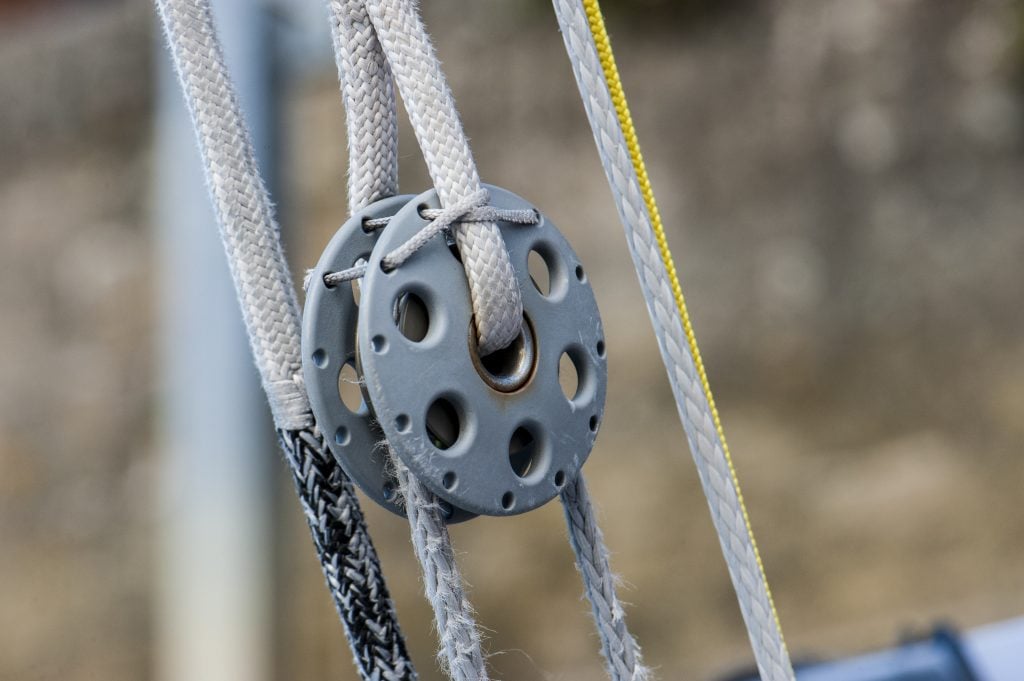
The installation of an adjustable braided Dyneema textile backstay is increasingly common. This operation does not necessarily require the services of a rigger. Indeed, what’s most complicated, when passing from stainless steel to textile rigging, is adapting the mast fixing point and cable terminations. In the case of the backstay (or runners), it is quite simple because there is always an attachment on the masthead, as well as on the boat. You can take the measurements yourself, buy a Dyneema SK78 braid (see text box: “Dyneema moduli”) with long pitches and splice both ends. In theory, the ideal solution would be to choose a braid which has been pre-stretched to its working load. The pre-stretching technique, which occurs after braiding removes the air from the braid, makes it more compact and stabilises its length. A braid which has not been pre-stretched will suffer from elongation after installation. In practice, this drawback is not really an issue because the elongation can be compensated for by the blocks and tackles. Note that a pre-stretched rope is much more expensive! Think about that…
I would like to install a textile inner forestay manoeuvrable from the cockpit organiser.
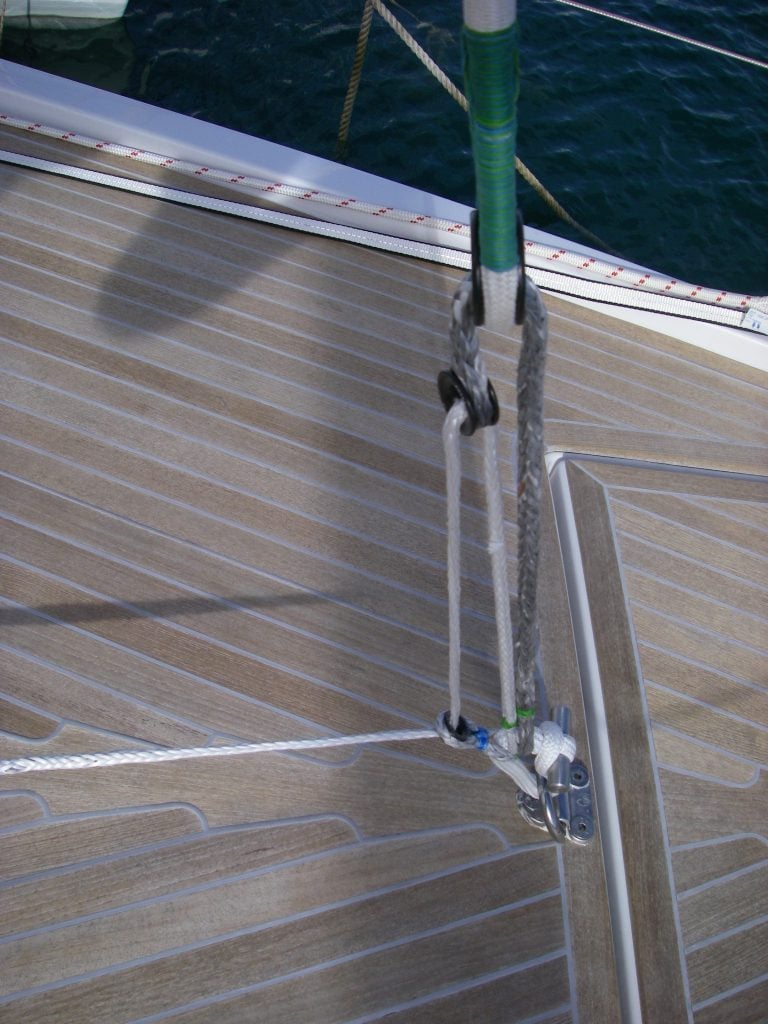
The textile inner stay is a valid option, even on board a cruising sail boat. The weight-saving is obviously a factor to bear in mind but it is not the main argument. This solution is safer than handling a cable that whips the air and the unfortunate crew member who volunteers to install it. A textile inner forestay is controlled from the cockpit and tensed, thanks to a block and tackle whose manoeuvre is transferred to the cockpit controls through fairleads. Unlike the backstay, the lifting length of the block and tackle is very weak (the block and tackle is very small) because of the sail snap hooks that must be as low down as possible on the stay. The 20 or 30 cm of block and tackle necessary to tauten it are not sufficient to absorb the elongation of a rope that has not been pre-stretched. For the stay to be really taut, it is indeed, indispensable to buy a pre-stretched braid. Its length is more stable and so is its resistance to abrasion: the braid, which is stiffer and more compact, has less surface in contact with the exterior. This is an important point as the snap hooks rub against the inner forestay when the sail is hoisted. Some rope-makers (not many) like FSE Robline, perform a particularly efficient pre-stretching technique: thermofixing, or “ultra-heat set and pre-stretched process”. This process is similar to pre-stretching but is performed with a higher temperature, at a precise hygrometric rate and extremely controlled tension. The ultra heat set and pre-stretched process aligns the molecular chains along the working axis of the fibres. Thermofixed Dyneema® ropes have practically no more elongation, which means that they have reached their working load length. But this process does not appeal to everyone: Some professionals consider that it accelerates the rope’s wear. Another more technical solution consists in making a textile cable with parallel fibres (filament winding technique). The properties are far superior, like the cost !
I would like to protect my halyards with a Dyneema chafe sleeve
That is an excellent initiative! Very resistant to abrasion and highly slippery, thanks to its very low friction coefficient, Dyneema is perfectly suitable for halyard protection on the masthead around sheaves and guides (never use Dyneema for chafe sleeves on clutches and winches, as it is much too slippery!). Installing a Dyneema chafe sleeve is additionally recommended on the foresail sheets, around the shrouds or on the cunningham, where the rope passes through the eye of the mainsail tack. A coated chafe sleeve withstands salt and UV aggressions very well. High exposure to chafing of the chafe sleeve requires a short braiding pitch combined with a large number of plaits (32 or 48). The very tight meshing of the chafe sleeve forms a kind of shield against wear. The short braiding pitch also withstands a strong bending radius, a constraint that the chafe sleeve has to bear, since it forms a 180° in the masthead sheave. The elasticity of this type of braiding in not a drawback because the chafe sleeve doesn’t bear the load of the rope. The chafe sleeve significantly increases the diameter of the rope: before getting started, check that the fittings are the right dimension! Bear in mind that installing a chafe sleeve already requires good skills in rope splicing. Do not hesitate to call upon the services of a professional rigger.
I would like to replace my stainless steel guard lines with Dyneema
Textile guard lines are a very effective alternative to stainless steel cables: it is a very lightweight system and it removes corrosion problems. The guard line is simply put under tension with Dynema lashing, which is more practical than the traditional turnbuckle because it is easy to install. To replace conventional guard lines safely and avoid a forced swim when crew heave to, it is essential to choose a textile cable with high resistance to abrasion. Thus, a braid with short pitch braiding is very suitable. But for stiffer guard lines (a short braiding pitch causes elongation), Ino-Rope offers a more upscale product (6 € / metre): A pre-stretched Dyneema SK78 modulus (see text box: “Dyneema moduli”) with a long braiding pitch for highly stable braid length. To avoid problems of wear (a rope with a long braiding pitch is more sensitive to chafing), the core is covered with Dyneema, a fibre that is more abrasion resistant than polyester. A covered rope also has the advantage of being more pleasant to handle: superior diameter and softer “touch” thanks to the tightness of the braiding. The best is the Dyneema cover with retro-reflecting plaits, visible at night. When passing through the deck stanchions, a high chafing area, the guard line is protected by heat-shrink sleeve sections. Clever, isn’t it ?
Setting up my customised guard lines !
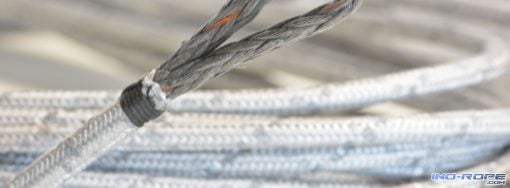
I would like an easy to splice Dyneema rope
Some ropes are more difficult to splice than others. Are you becoming addicted to splicing? Make things easier! Choose coated braids: coated with a polyurethane film, the fibres are smooth. They do not get caught on the needles and remain stuck together. For loops and textile shackles, 16-plait braids with a short braiding pitch are ideal. They are easy to splice, resist well to chafing and can bear a small bending radius. Some ropes with extremely tight braiding pitches are almost impossible to splice! Very stiff and hard to the touch, they are designed for particular applications where abrasion is a major cause of wear. Dyneema® braided rope of this type is used make mast foot blocks and tackles for windsurf boards, for example. Useful information: after splicing on a strop, the rigger pre-stretches the rope, even when working on a rope that has already been pre-stretched by a rope maker. The handling of the braid makes it puffier. When under load, a splice gives between 2 and 4 cm in length (for a 10 mm diameter rope). For use where elongation could be a problem, pre-stretching is essential in order to obtain a good quality product. Last point before break time, note that there are braids with sticky coating, specially designed for easy splicing. Each rope maker invents their own secret magic formula, jealously guarded! In any event, coating makes the handling and braiding work much easier.
I would like to have a spare textile shroud
For long off shore navigation, it is wise to have a spare cable in case of damage to the rigging. Saying that replacing a shroud or a stay with a Dyneema braid is fun, would be slightly too sales-oriented. But within the scale of problems on board, this operation remains quite low down. Colligo Marine has designed a spare, ready to use shroud kit. It is “quite simply” a Dyneema braid with a splice around a thimble at each end. It is installed with a lashing that enables the tension to be adjusted. Clever but costly. You could possibly prepare your own spare cable. Shrouds and elongation do not go well together. The right rope to hold your mast is an SK78 modulus pre-stretched braid with a long braiding pitch. Are you dreaming of faraway seas? Don’t rush things; take advantage of the peace and comfort of the harbour to splice all the way to the departure day !
Les modules de Dyneema
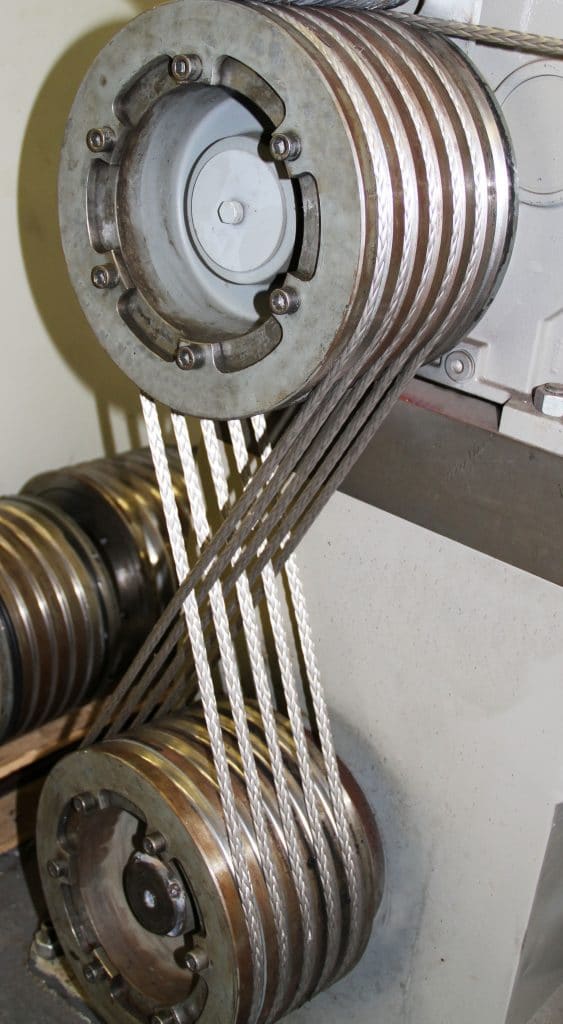
Since the invention of high modulus polyethylene by Albert Pennings in 1963, the chemical soup has been constantly evolving, in order to improve the mechanical properties of the fibre. The moduli correspond to different qualities of Dyneema that have been developed by DSM since 1990: SK38, SK62, SK75, SK78, SK99, etc. Although the molecular recipe varies according to the modulus, the basic ingredients remain the same. Today, there are more than ten types of Dyneema but only two to three moduli (or formulae, if you prefer) are commonly used. This trend is, however, beginning to change because new moduli are appearing on the cruising market.
- Dyneema SK38
This new Dyneema modulus provides equal resistance to polyester but with lower elongation. The SK38 was recently developed for cruising sailing boat halyards that do not require a high Dyneema modulus. - Dyneema SK75
It is a “classical” Dyneema modulus but it is already a good quality product. Its elongation is approximately 4%. Its creeping rate is medium, even high, which makes it unsuitable for halyards, backstays and inner forestays. Therefore, its use is specifically for textile connections and sheets. - Dyneema SK78
This modulus has resistance and elongation properties that are identical to Dyneema SK75, but with reduced creeping. Combined with a long braiding pitch and pre-stretching (to optimise stability under load); the Dyneema SK78 is quite suitable for halyards and “adjustable” standing rigging (inner forestay, backstay, runners). - Dyneema SK99
The Dyneema SK99 has replaced the SK90 modulus. Its elongation is lower than that of the SK75 and SK78 moduli. It is closer to 3%. Its creeping is between low and medium but the resistance of the SK99 is 20 to 25% higher. Creeping only begins at 25% of the braid’s breaking load. The more resistant the braid is, the less it risks reaching the “creeping point”. The Dyneema SK99 modulus is, therefore, suitable for “adjustable” standing rigging. Having said that, this very high quality fibre is currently only used for offshore racing.
Terms for understanding Dyneema
- Elongation
Rope elongation has two causes. The elasticity of the fibre itself, but also the elasticity of the braid, which varies depending on the braiding pitch. Elongation varies according to the load applied to the rope. When the latter is no longer under load, it goes back to its initial length. Elasticity must not be confused with creeping, which is irreversible elongation under a very high and extended load. - Coating
Coating is a process whereby the rope is soaked in a polyurethane solution. Coating is a heat treatment performed in an oven, at the same time as pre-stretching. Polyurethane forms a film around the Dyneema® twines, which protects them from external aggression (salt crystal, sand, chafing etc.). - Creeping
Creeping corresponds to an irreversible increase of the rope’s length, which occurs beyond a high level of constant tension (25% of the breaking load) over a long period. Creeping is the opposite of stability under load. Creeping must not be confused with elongation. Elongation corresponds to elasticity: once the “over-tension” period has passed (gust of wind, for example), the rope goes back to its initial length. Creeping can be compared to chewing-gum. Imagine a string of chewing-gum on which you suspend a light weight: the chewing-gum undergoes elongation but not irreversibly. When using Dyneema within its working load, there is no reason for creeping to occur. This problem only occurs with lateral standing rigging (shrouds), which will not be discussed here. - Cover
The cover protects the core of the rope from external aggressions (UVs, abrasion) and ensures a good grip in cleats and clutches (otherwise the core would slide). A rope does not necessarily have a cover. - Braiding pitch
The braiding pitch is the frequency with which a plait recovers the same position in a braid. The more perpendicular the angle of the plait is to the axis of the rope, the tighter the braid is (short braiding pitch). The more parallel the angle of the plait is to the axis of the rope, the longer the braiding pitch is. The mechanical properties of the rope stem from this, due to the braiding type. The longer the braiding pitch is, the less elastic the rope is. - Pre-stretching
Pre-stretching is the process of stretching a braid after its fabrication in order to stabilise its length, so that it does not undergo elongation when it is first used. A pre-stretched textile cable has superior mechanical properties: its length is more stable and its diameter is inferior for the same resistance (the braid is more compact). There is a specific technology for Dyneema: the ultra heat set and pre-stretched process (higher temperature, very precise hygrometry and tension level), which is even more efficient. The braid becomes extremely compact and stiff. This technique requires heavy tooling that not all rope makers can afford. - Chafing/Abrasion
Chafing or abrasion is the wear of fibre due to friction under load against another element (sheave, clutch, winch, shroud…). It is a major cause of wear to be checked regularly. - Résistance
Breaking load is the load that a rope can withstand before breaking. The resistance of the core, witch bears the tension of the rope, is tested on a tensile bench adapted by the manufacturer. Bear in mind that this test is done without a knot, which would lead to a decrease in the breaking load (- 45% for a bowline knot and – 5% for a conventional splice). - Chafe sleeve
The chafe sleeve corresponds to the third “layer” of a rope (core, cover, chafe sleeve) It provides extra protection around the areas subjected to high chafing (sheaves, clutches and cleats, winches).

An article published in Voile Magazine (n°254), written thanks to the expertise of d’Ino-Rope and the Corderie Lancelin.
-

-
 ⌀ de 5 à 16 mmRope for frequent use (cruising, regatta…) low elongation | Dyneema®2,22 € – 22,16 € TTC
⌀ de 5 à 16 mmRope for frequent use (cruising, regatta…) low elongation | Dyneema®2,22 € – 22,16 € TTC -

-
 ⌀ de 2 à 10 mmLine for lashing, abrasion resistant | Dyneema®1,04 € – 15,12 € TTC
⌀ de 2 à 10 mmLine for lashing, abrasion resistant | Dyneema®1,04 € – 15,12 € TTC



